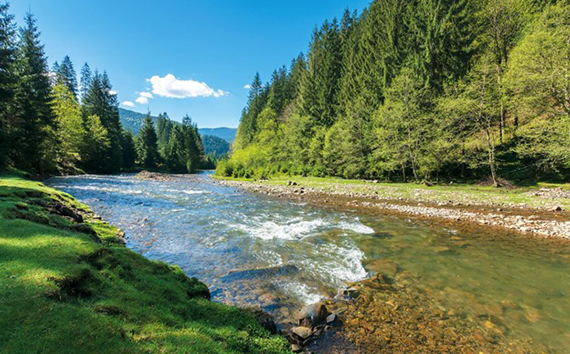Choosing between Terrapass vs. Cool Effect isn’t easy — both offer high-quality carbon offset programs that allow businesses and individuals to reduce their environmental impact. But what’s the distinction between these two offset providers? And which one offers the best carbon offset programs?
This guide explores the Terrapass vs. Cool Effect, comparing things like carbon offset projects, standards, rates, and more. We’ve also included a brief overview of why people buy carbon offsets and how they help fight climate change.
What Are Carbon Offsets?
Carbon offsets refer to tradable certificates known as carbon credits, which fund projects that diminish the impact of greenhouse gas emissions (GHG emissions). One carbon credit offsets one metric ton of carbon dioxide (CO2), which the average car will produce in three months. To compare, it takes 40 years for one tree to absorb one ton of CO2.
You’ll also see carbon offsets that cover one metric ton of “CO2e.” Since carbon dioxide has more impact on our environment than other GHGs, other GHGs are measured against it as CO2e (CO2 equivalent).
Purchasing carbon offsets allows businesses and individuals to reduce their carbon footprint beyond what they’re likely to achieve through individual action. So, in other words, carbon offsets offer a cost- and time-effective method of minimizing our carbon footprints.
Initiatives and activities funded by carbon offsets might include:
- Reforestation and afforestation (tree planting in an area that was not previously forested)
- Forest conservation and management
- Wind farms, hydropower projects, solar power plants, and other renewable energy projects
- Landfill gas capture and management
- Providing energy-efficient cookstoves and appliances to local communities
- Farm power, methane capture, and biogas production
- Waste management
Each activity aids in emission reduction or the production of renewable energy. And purchasing carbon credits on the carbon market allows you to fund these activities to offset your carbon footprint and protect the environment.
What Is a Carbon Footprint?
Your carbon footprint refers to the total amount of carbon emissions you produce through daily life and travel each year. The average person in the United States has a carbon footprint of 16 tons — globally, the average carbon footprint is about 4 tons.
If you’d like to find out what your carbon footprint is, Terrapass features a free carbon footprint calculator. It allows you to calculate how many tons of CO2 you or your household produces each year based on the following:
- Vehicle type and use
- Home energy use
- Public transit
- Air travel
While you can directly reduce your carbon footprint in some areas (e.g., by increasing energy efficiency with appliances, windows, and insulation in your home), other sources of emissions are currently unavoidable. For example, sustainable air travel is not yet available, but you can purchase carbon offsets to mitigate a portion of the CO2 produced by your flight.
Becoming Carbon Neutral
When a person or business balances their carbon footprint through carbon offsetting, they can become carbon-neutral. So, if your carbon footprint is 10 tons of CO2 each year, and you purchase 10 metric tons of carbon offsets, you would become carbon neutral.
Each person who becomes carbon neutral is doing their part in preventing global warming, preserving biodiversity, and improving environmental sustainability. On a larger scale, the EU has committed to carbon neutrality by 2050 to limit global warming to the suggested safe threshold of 1.5 degrees Celsius.
Terrapass vs. Cool Effect: How Do They Compare?
Choosing between two high-quality providers, like Terrapass and Cool Effect, isn’t always easy. So let’s compare their projects, standards, and plans to help you decide.
Who Is Terrapass?
Terrapass has been helping individuals and businesses reduce their impact on the climate since 2004. It was launched by Dr. Karl Ulrich at the University of Pennsylvania and 41 of his students to help people reduce the climate impact of driving.
In its first year, Terrapass reduced 36 million pounds of CO2 and registered over 2,400 members. It soon expanded to address GHG emissions from energy consumption and flying. It has since helped hundreds of thousands of individuals and over 1,000 corporations, institutions, and businesses take responsibility for their carbon footprints.
The efforts by the Terrapass team have resulted in dozens of renewable energy and greenhouse gas destruction projects, reducing GHG in our atmosphere by billions of tons of CO2 and CO2e. The multidisciplinary team behind Terrapass is dedicated to fighting climate change and providing resources to help people understand and take responsibility for their climate impact.
Some of the ways it does this include:
- Providing educational resources, like their carbon footprint calculator
- Helping businesses prepare complex carbon footprint analyses
- Creating, implementing, and operating emissions reductions projects
- Helping institutions and companies develop renewable energy solutions and sustainable development goals
As a for-profit social enterprise, Terrapass can support products that destroy GHG and produce renewable energy to better fight climate change. In addition, by running its business as a business, Terrapass is better able to conduct an efficient operation that can rise to the challenge.
What Does Terrapass Offer?
Terrapass offers one-time and subscription-based purchases of carbon offsets that help support carbon reduction projects. It also offers renewable energy certificates (RECs) and Bonneville Environmental Foundation (BEF) Water Restoration Certificates® (WRCs).
RECs support clean energy projects and represent rights to renewable energy generation. One REC represents one megawatt-hour (MWh) of renewable energy and its environmental benefits. All Terrapass RECs are Green-e energy certified.
BEF WRCs directly support the restoration of ecological vitality in freshwater ecosystems. One WRC represents 1,000 gallons of clean water restored. Buyers can purchase WRCs to offset their water footprint.
A water footprint is your total daily use of tap water and the water used to produce your home goods, gas, electricity, and food. The average water footprint for a person in the United States is 1,802 gallons per day.
The rates for Terrapass carbon offsets, RECs, and BEF WRCs® are:
- One carbon offset (1,000 lb. CO2): $7.99
- One REC: $15.99
- One BEF WRC (1,000 gallons): $4
What Projects Does Terrapass Fund?
In 2022, Terrapass supported seven projects related to wind energy, ecosystem restoration, landfill gas capture, deforestation prevention, and environmental conservation. Since its launch in 2004, it has funded and supported dozens of sustainable living projects to help combat global warming and aid carbon reduction. These include:
- Forestry: Terrapass supports nine forestry projects in locations including Indonesia, Peru, Quebec, Kenya, Brazil, Alaska, and California.
- BEF WRCs: Terrapass supports three BEF WRCs in California and Arizona.
- Renewable energy: Terrapass supports six wind power and renewable energy projects in Aruba, Texas, South Dakota, Oklahoma, North Dakota, and Indiana.
- Abandoned coal mine methane capture: Terrapass supports one abandoned coal mine methane capture project in Pennsylvania.
- Landfill gas capture: Terrapass supports 12 landfill gas capture projects in Ontario, Mexico, Virginia, Michigan, North Carolina, Mississippi, Georgia, New York, Florida, and Wisconsin.
- Farm power: Terrapass supports four farm power projects in Washington, Mississippi, California, and Wisconsin.
How Does Terrapass Verify Projects?
Terrapass ensures its projects make a difference through due diligence, monitoring, and verification. In addition, all projects supported by Terrapass must pass the “additionality” test. Carbon reductions are “additional” if they would not have occurred without the project.
In other words, selling the carbon offset to fund the project must be the reason why the carbon reduction occurred for the project to pass the additionality test.
For example, if carbon offsets fund a methane capture project and reduce emissions as a direct result, the project qualifies as additional. But if a land owner sells carbon offsets for the existing trees on their property, this project would not pass the additionality test because the carbon reductions would have happened either way.
This test is essential to ensure all Terrapass projects are effectively helping combat GHG emissions. For example, suppose individuals or businesses purchase carbon offsets that do not pass an additionality test. In that case, they’re not reducing their environmental impact and are instead omitting actions that would reduce it.
What Carbon Standards Does Terrapass Use?
Terrapass works with each project developer to verify the GHG reductions according to leading standards. The six carbon standards it uses include:
- Verified Carbon Standard (VCS)
- Climate Action Reserve
- Green-e
- Gold Standard
- CSA Group
- American Carbon Registry
Who Is Cool Effect?
Cool Effect was officially launched in 2015 by Dee and Richard Lawrence to raise awareness of carbon credits and change the conversation surrounding climate change. The Cool Effect platform has since expanded to encompass 15 projects worldwide and has helped hundreds of thousands of individuals and businesses reduce their emissions.
The efforts Cool Effect supports began with a project to bring clean-burning cookstoves to local communities in Honduras. Today, it funds various projects that make reducing carbon pollution easier for its supporters.
Cool Effect is a registered 501(c)3 nonprofit organization that accepts donations in exchange for carbon offsets. It functions as a crowdfunding platform through which individuals and businesses can offset their carbon footprint by funding carbon-reducing projects.
What Does Cool Effect Offer?
Cool Effect offers one-time and subscription-based options for individuals and businesses to put money toward carbon reduction projects. The rates for Cool Effect carbon offsets are:
- One metric ton of CO2e reduction: $10.87 to $38.26 (average of $14.62)
Users can also buy carbon offsets for air travel, entering how many flights they took and how many hours they were on the plane.
What Projects Does Cool Effect Fund?
Cool Effect has met the financial goals needed to support four projects relating to environmental conservation, methane capture, and renewable energy. It continues to raise funds for the following carbon reduction projects:
- Methane capture: Cool Effect supports one methane capture project in China.
- Efficient cookstoves: Cool Effect supports one efficient cookstove project in Honduras.
- Ecosystem protection: Cool Effect supports seven environmental conservation and protection projects in Indonesia, Myanmar, Mexico, Kenya, Uganda, Montana, and Colorado.
How Does Cool Effect Verify Projects?
Cool Effect verifies its projects to ensure they make a difference through a verification process that includes discovery, authentication, and selection. In addition, projects supported by Cool Effect must pass their additionality test to confirm that they legitimately reduce carbon pollution.
What Carbon Offset Standards Does Cool Effect Use?
Before supporting a project, Cool Effect checks to see that it’s verified by at least one of five carbon standards:
- Verified Carbon Standard (VCS)
- Climate Action Reserve
- Gold Standard
- American Carbon Registry
- United Nations Clean Development Mechanism
Terrapass vs. Cool Effect: How Do Prices Compare?
Terrapass and Cool Effect only support projects that meet the highest standards, so they cannot match the lower rates offered by companies that ignore quality, verification, and additionality. However, the rates are competitive and affordable when you compare Terrapass vs. Cool Effect or against similar high-quality providers.
Below, we’ve highlighted information comparing plans and rates between Terrapass vs. Cool Effect.
What Plans and Rates Does Terrapass Offer?
Terrapass offers the following plans, certificates, and rates for those looking to purchase carbon offsets, RECs, and BEF WRCs:
- Carbon Balanced Living Plan: Starting at $8.34 per month
- Personal Carbon Offset Plan: Starting at $7.49 per 1,000 pounds per month
- Flight Carbon Offset Plan: From $8 to $80 depending on flight distance
- EcoTourist Bundle: $64
- Green Wedding Carbon Offsets: From $7.99 to $14.99 per attendee
- BEF WRCs: $4 per 1,000 gallons
- RECs: $15 per MWh
What Plans and Rates Does Cool Effect Offer?
Cool Effect offers the following prices and plans for those who wish to make one-time or monthly purchases of carbon offsets:
- One carbon offset: $10.87 to $38.26 (price varies according to the specific project; the average cost is $14.62)
- Air travel: 1 tonne equals $14.62
Terrapass vs. Cool Effect: Where Should You Buy Your Carbon Offsets?
The above Terrapass vs. Cool Effect comparison highlights differences in the number and range of projects supported and slight differences in price. However, both providers support carefully vetted projects and worthy causes at fair prices.
But who wins between Terrapass vs. Cool Effect? Terrapass would be the preferred choice if you’d like a provider that offers the most options to offset your environmental impact with a more extensive and versatile catalog of projects. With Terrapass, you can purchase carbon offsets, RECs, and BEF WRCs with access to a range of convenient one-time purchase and subscription services.




